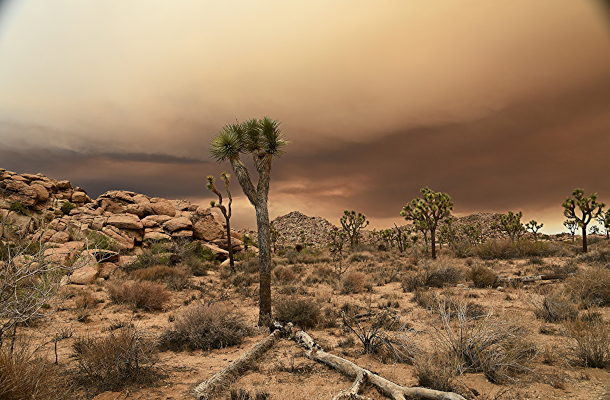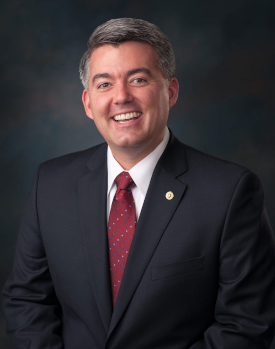Funding the National Parks, Finally
Air Date: Week of August 7, 2020

Joshua Tree National Park is one of the many parks which will benefit from the Great American Outdoors Act. (Photo: Bob Glennan, Flickr, CC BY NC ND 2.0)
For years national parks and public lands in the United States have been severely underfunded. The Great American Outdoors Act is set to help turn that around, with billions of dollars to address maintenance backlogs and support new conservation. Linda Bilmes, Senior Lecturer in Public Policy at Harvard University and author of Valuing U.S. National Parks and Programs: America's Best Investment, joined Host Steve Curwood to talk about what this legislation means.
Transcript
CURWOOD: Despite the celebratory tone both on Capitol Hill and at the White House a number of environmental advocates did not want to give so much credit to the Trump Administration, with its record of rolling back more than 70 environmental regulations. These critics include Linda Bilmes who served in both the Clinton and Obama Administrations. Now a senior lecturer at Harvard’s Kennedy School she has written about the unmet needs of the parks and the economic benefits they provide.
BILMES: Steve, I think one of the great ironies is that a man who has been the worst president for the environment and for conservation, certainly in my lifetime, gets to have his name on the most important piece of conservation legislation in 50 years. I mean, this is a man who has, you know, rolled back protections for national monuments who has slashed Bear Ears National Monument by 80%. And Grand Staircase Escalante, who has weakened the Endangered Species Act, and watershed protections and a wide swathe of environmental rules and regulations. And who has, in particular opened oil and gas drilling across most of U.S. coastal waters. He also ironically, just as recently as February, tried to slash the discretionary funding for the Land and Water Conservation Fund by 97%. And yet, such is the craziness of this pandemic, and FY-2020, that this President will have his name on this very important piece of legislation. It is irony but I think we have to accept that it's a bit of a silver lining of the strange times that we live in.
CURWOOD: I asked Linda Bilmes to outline the provisions of the landmark legislation.
BILMES: And the great American outdoors Act has two main parts. First of all, it sets up a National Park and Public Lands Legacy Restoration Fund that provides about nine and a half billion dollars over the next five years to fix the national parks deferred maintenance problem, and it devotes about $6.5 billion $1.3 billion per year to the national parks maintenance backlog. It also provides about $3 billion dollars to other public lands, such as national forests and wildlife refuges and other federal lands.

Republican Senator Cory Gardner (R-CO) championed The Great American Outdoors Act alongside Democratic Senator Joe Manchin (D-WV). (Wikipedia, Public Domain)
CURWOOD: And talk to me now about the second part of this, this Land and Water Conservation Fund. Why is this Conservation Fund so important and what was its financing for it before?
BILMES: So the Land and Water Conservation Fund was created in 1964. And it's actually a very wonderful and simple idea, which is to take some of the royalties from oil and gas drilling on federal lands in federal waters, and set them aside for conservation of land and waters around the United States, both to the national parks and other federal land agencies and importantly to state and local parks who can apply for matching grants. Now it is authorized for up to $900 million dollars a year which means that's the amount that is actually taken from oil and gasoline synched royalties. But in the past, Congress has only appropriated a small fraction of that amount, in some years, a very, very small fraction to actual land and water conservation. So what this bill will do is it will mandate in perpetuity, that the full $900 million a year goes to the intended purpose, which is conservation on local state and federal lands and waters.
CURWOOD: So this is a bit of inside Washington speak the difference between an appropriation and an authorization. Authorization says, okay, you guys could do this, but appropriation pushes the cash register to go cashing. A question, though, over the near term, then funding is dependent on fossil fuels. Those markets have been fairly volatile at what risk is the government of not getting the royalties necessary to support this program?
BILMES: I think the risk is very low because compared to the overall sums of money involved in oil and gas royalties $900 million a year, although it seems like a fair amount of money, that really is a small fraction of the overall take. You know, the National Parks depends on a variety of funding streams: user fees, appropriations, Land and Water Conservation Fund, money, philanthropy. And this stream is quite variable quite volatile. So the amount of money that is available for any individual Park year to year is volatile. And one of the things that makes managing the national parks very challenging is dealing with this volatile stream of funding. So this at least guarantees that there is a certain amount of funding over the next five years for maintenance and repairs and a certain amount of reliable money through the Land and Water Conservation Fund.
CURWOOD: So this was a bipartisan vote. The bill passed the Senate with 73 - 25 vote and then the House agreed to the Senate version with a 310 to 107 vote. What do you think was the magic sauce here? How did this at bring together Democrats and Republicans?

Linda Bilmes is a Senior Lecturer in public policy at the Harvard Kennedy School and author of Valuing our National Parks: America’s Greatest Investment. (Photo: Diana Bowen/NPS)
BILMES: Well, I think we can thank the very unusual circumstances created by the pandemic, in which three factors the politics, the economics and public opinion converged. First of all, politically, there has been a fair amount of bipartisan support for the national parks and for conservation for many years. However, the particular secret sauce this time was that a number of members of Congress from endangered seats in the West Particularly Senator Steve Daines of Montana and Senator Cory Gardner of Colorado who are facing very stiff challenges from popular Democrats in those states. They championed this and had a meeting with President Trump, in which they said this is a must have, you've got to sign this piece of legislation which has bipartisan support that we are lining up in order for us to have any chance of retaining these Senate seats and for the Republicans having a chance of retaining the Senate. So this became a critical political requirement for the Republican majority and for the majority leader, as well as for a number of senators and congressmen from both parties who have been long champions of the national parks. Secondly, the economics of this great American Outdoors Act is that it will create at least 100,000 good jobs in maintaining and repairing sites, so this was very appealing in the current environment.
CURWOOD: So it's documented that communities of color and Latin X communities aren't seen in the national parks and other public lands at the same rate as white folk. Why is that?
BILMES: There are a couple of factors that explain why there's an over representation of white people in the National Park but the biggest factor is that the average age of a National Park visitor is 63 and the country was less diverse at that time. A second issue is that the National Parks have been at least up until perhaps 20 years ago, they've not been telling everyone's American story. And over the last decade, the National Parks have made a very concerted effort and I think a great deal of progress toward telling the story of all Americans.
CURWOOD: Professor Linda Bilmes is a senior lecturer in Public Policy, Public Finance at Harvard's John F. Kennedy School of Government. Thank you so much for taking the time with us today.
BILMES: Thank you so much. This is such a wonderful program.
Links
NY Times | “Trump Weakens Major Conservation Law to Speed Construction Permits”
Washington Post | “Trump scales back landmark environmental law”
NPR | “President Trump Overhauls Key Environmental Law to Speed Up Pipelines and Other Projects”
Living on Earth wants to hear from you!
Living on Earth
62 Calef Highway, Suite 212
Lee, NH 03861
Telephone: 617-287-4121
E-mail: comments@loe.org
Newsletter [Click here]
Donate to Living on Earth!
Living on Earth is an independent media program and relies entirely on contributions from listeners and institutions supporting public service. Please donate now to preserve an independent environmental voice.
NewsletterLiving on Earth offers a weekly delivery of the show's rundown to your mailbox. Sign up for our newsletter today!
 Sailors For The Sea: Be the change you want to sea.
Sailors For The Sea: Be the change you want to sea.
 The Grantham Foundation for the Protection of the Environment: Committed to protecting and improving the health of the global environment.
The Grantham Foundation for the Protection of the Environment: Committed to protecting and improving the health of the global environment.
 Contribute to Living on Earth and receive, as our gift to you, an archival print of one of Mark Seth Lender's extraordinary wildlife photographs. Follow the link to see Mark's current collection of photographs.
Contribute to Living on Earth and receive, as our gift to you, an archival print of one of Mark Seth Lender's extraordinary wildlife photographs. Follow the link to see Mark's current collection of photographs.
 Buy a signed copy of Mark Seth Lender's book Smeagull the Seagull & support Living on Earth
Buy a signed copy of Mark Seth Lender's book Smeagull the Seagull & support Living on Earth

